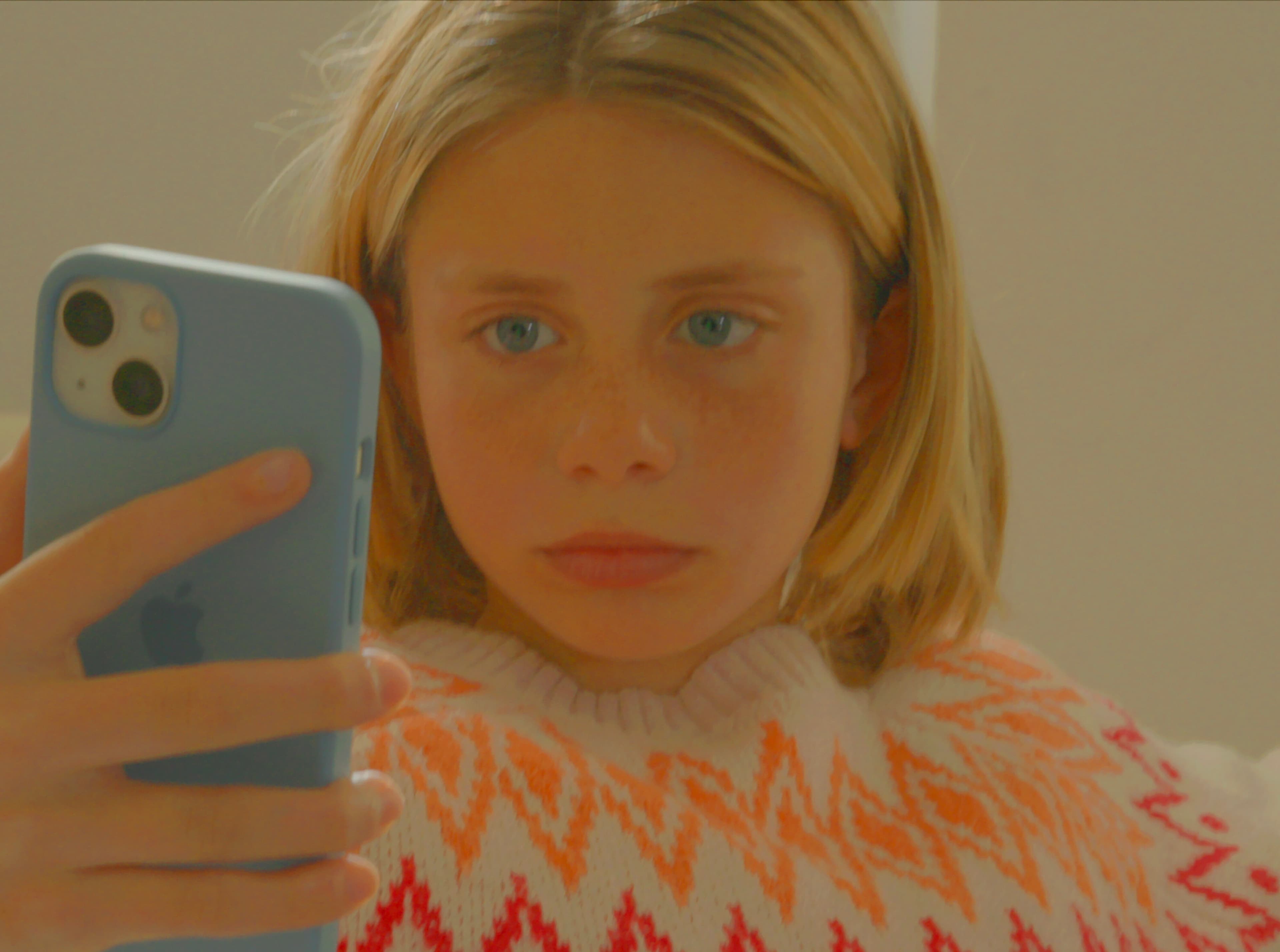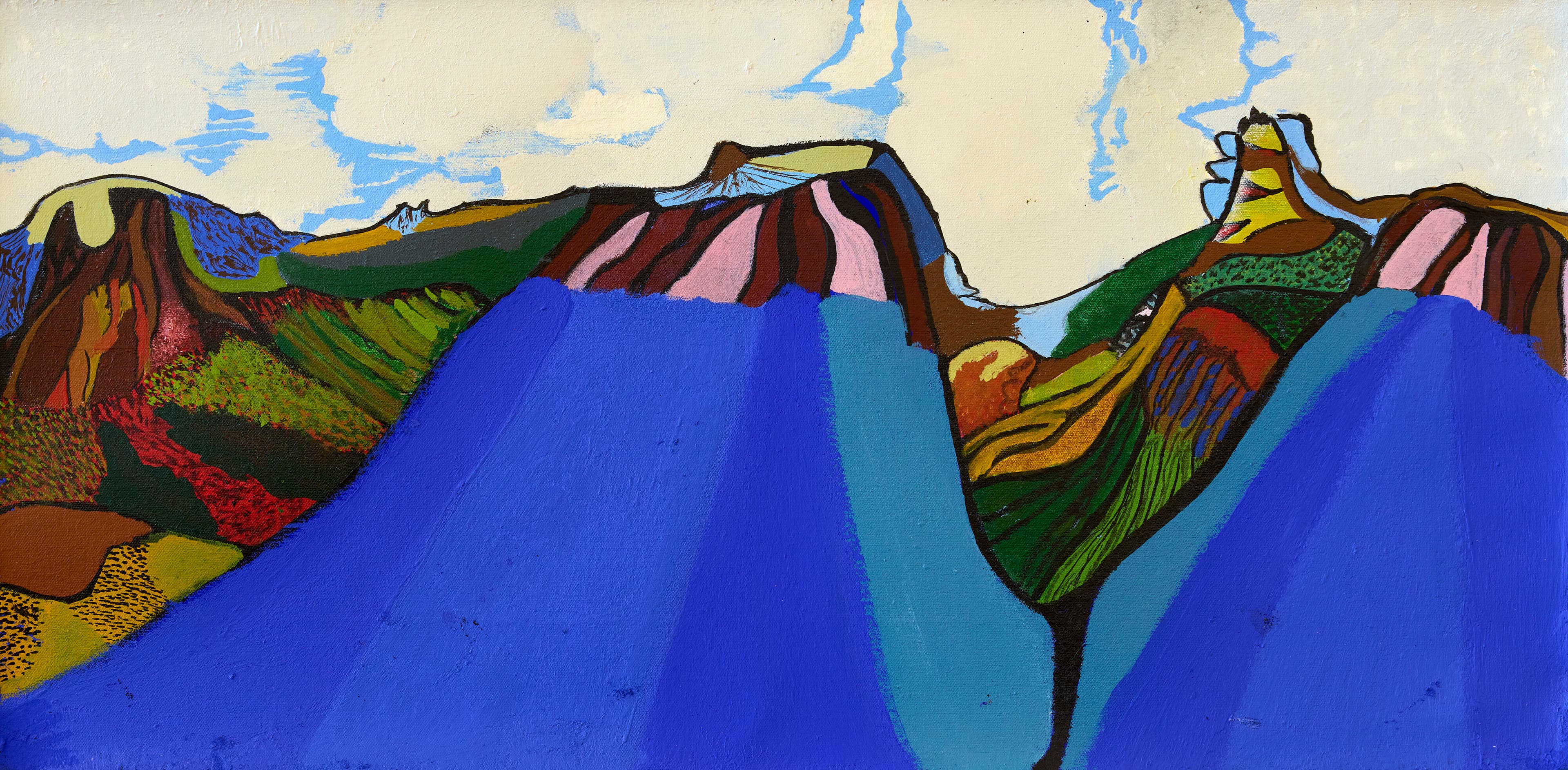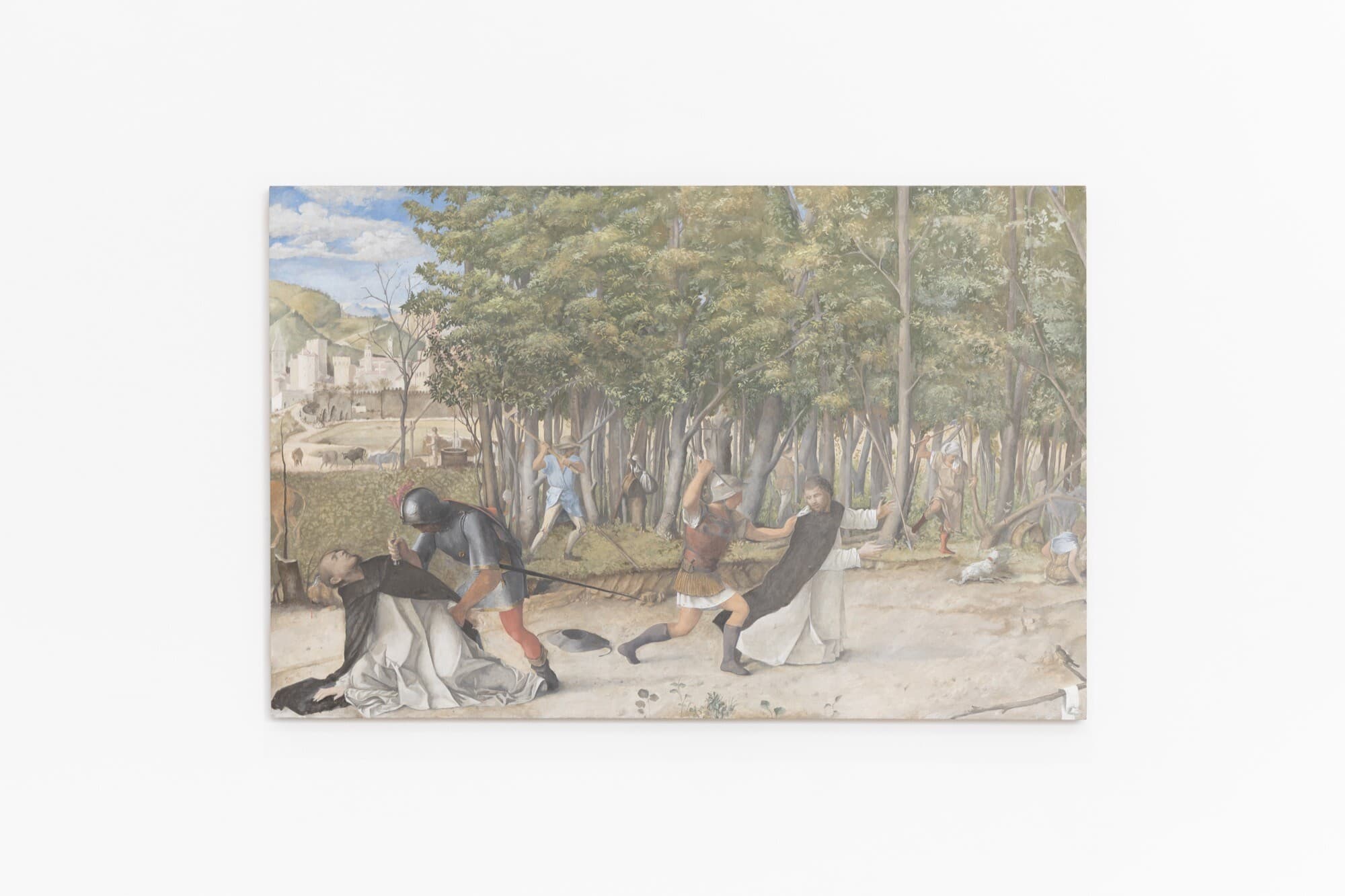Hair Pieces installation view, Heide Museum of Modern Art, photograph: Christian Capurro.
Hair Pieces
Diego Ramirez
Hair Pieces is a sizeable exhibition featuring thirty-eight artists about hair curated by Melissa Keys. I was surprised to find there’s an entry fee of $25, which made me realise that I’ve deludedly convinced myself that I can simply walk into exhibitions. According to Heide’s latest public annual report in 2023, they generated $878,336 in admissions, comparable to their programming expenses of $820,299. Their highest operational figure is employee benefits, totalling $2,497,446, although without context, it’s unclear whether this is impressive or not. Coming from the artist-run sector, I’m intrigued by the notion of an entry fee and curious about the melons (slang for millions in Mexico), for it seems ironic that we pay to see exhibitions at public institutions—which have substantial resources available—while we experience art for free in more precarious spaces. Same art, different wall. I’m not trying to make an intelligent remark—we are living a lie!
One could argue that the entry fee serves as a boundary delineating the space and signalling the rules of entry, imbuing the air in the room and the freedom to roam with a more precious feeling. The fee additionally distinguishes blockbuster exhibitions from collection shows and museums from galleries. Upon payment, Heide offers a wristband, symbolising an administrative limit, by granting access to the bearer. There’s no physical barrier preventing visitors from stomping into the exhibition; instead, entry is mediated through a market exchange that is surveilled by staff. This circles back to Hair Pieces, which prompts various reflections on how hair punctuates categorical boundaries.

Hair Pieces installation view, Heide Museum of Modern Art, photograph: Christian Capurro.
The exhibition weaves together multiple lines of signification, to braid a wide enquiry into this cypher of difference. Working with hair, like aluminium foil, is difficult because it is a common trope in contemporary art. This is humorously depicted in the satirical film The African Desperate (2022), where MFA student Palace Bryant presents hair pieces as part of her graduation work. This makes an entire show about hair a difficult undertaking, yet the local press has responded positively. The Guardian featured it with the wacky headline “Hairy, scary and extraordinary,” while The Sydney Morning Herald asked “Bad hair day?” Memo doesn’t use titles for its exhibition reviews, but if it did, I would suggest “Are you losing your hair!?”
Hair Pieces takes an identity politics approach, mixing everyday observations with the intricate gender and racial knots that various artists seek to untwist. The show has a broad scope, and is indeed far-reaching, as it tangles intergenerational local and international artists with names as varied as Marina Abramović, Christina May Carey, and Christian Thompson. This poses a challenge for this review, reflecting the difficulty that I encountered as an audience member in choosing one strand of thought to decipher the show with sufficient depth. Hair Pieces shifts between hair as horror, gender, race, and as shared experience, displayed across a few gallery spaces in ways that may appear disorienting, tautological, or fractured at times. On the other hand, it could be read as an attempt to create an intersectional narrative from the perspective of identity politics.
Sara Ahmed argues in Affective Economies that fear and anxiety produce borders under the presumption that a transgression has already occurred. While the affect in Hair Pieces may seem simplistic, it is intimately tied to the idea of hair as a boundary that has been subject to social, cultural, and political surveillance over time. Hair is often used to draw categorical limits and disorganise subjects into clusters of class, gender, and race. According to Ahmed, affect demands policing to prevent trespassing, energised by a pre-emptive fear. She uses white supremacism as an example, explaining how supremacists justify their hatred with patriotic love, creating borders to avoid enmeshment with others. It is interesting to consider what specific boundaries hair represents in various contexts to warrant such scrutiny. However, this is where the generous scope of the show became a hindrance, as the lack of specificity caused works to pull in different directions, preventing sustained engagement. Yes, I quote Sara Ahmed and use the word “affect” now—somebody, please like me.
Kemang Wa Lehulere’s video work Pencil Test 2 (2012) exemplifies how dominant structures have used hair to create oppressive boundaries. This work, fitting nicely within the lineage of the performance-on-video tradition, features a self-portrait of the Johannesburg-based artist inserting pencils in his curly hair. It is displayed on a CRT TV that displaces this piece from 2012 into an earlier era, and strangely frames this work as a “classic”—similar to how we often encounter videos from the 1970s in art history books, like Martha Rosler’s Semiotics of the Kitchen (1975). The piece consists of minimal montage, showing the shirtless artist, alternated with close ups of the pencils in his hair. This highlights the textures of his hair and the tone of his skin, commenting on racial profiling.
According to the didactic, the work addresses the history of apartheid in South Africa. The box monitor, with its retro materiality, also echoes this act of “remembering.” During apartheid, the government used a pencil test to segregate the population: the pencil supposedly would fall from a white person’s hair but stay lodged in the hair of a racialised person. Lehulere’s piece seamlessly integrates this racist profiling into the aesthetics of performance-based art. By inserting pencils in their hair, he mirrors acts of mark-making or sculptural play on objects, akin to artists like Erwin Wurm. This contrast reveals the policing that different bodies endure and the historical baggage that weighs upon them.

Hair Pieces installation view, Heide Museum of Modern Art, photograph: Christian Capurro.
There are also upbeat moments in the show that elicit reactions like “ew” and “brr,” such as when contemplating loose strands of hairs, which most people find unpleasant. Charlie Sofo and Debris Facility explore this aversion in their installation Found Combs (2007–ongoing), a display cabinet of lost combs illuminated by neon light. It blends Sofo’s playful compositions with Facility’s interest in discarded commodities. The combs, in bold colours and different sizes, are set against a perfectly white background, resembling the Y2K aesthetics of Damien Hirst’s pill cabinets and Takashi Murakami’s collaboration with Louis Vuitton. While some combs look more used and fucked-up than others, the underlying affect is aversion, as the hygienic display accentuates the abject presence of loose strands tangled in the found items. The intimate nature of these personal objects, now made public through the vitrine, feels like a dystopian Sephora, making us look away while drawing us in closer.
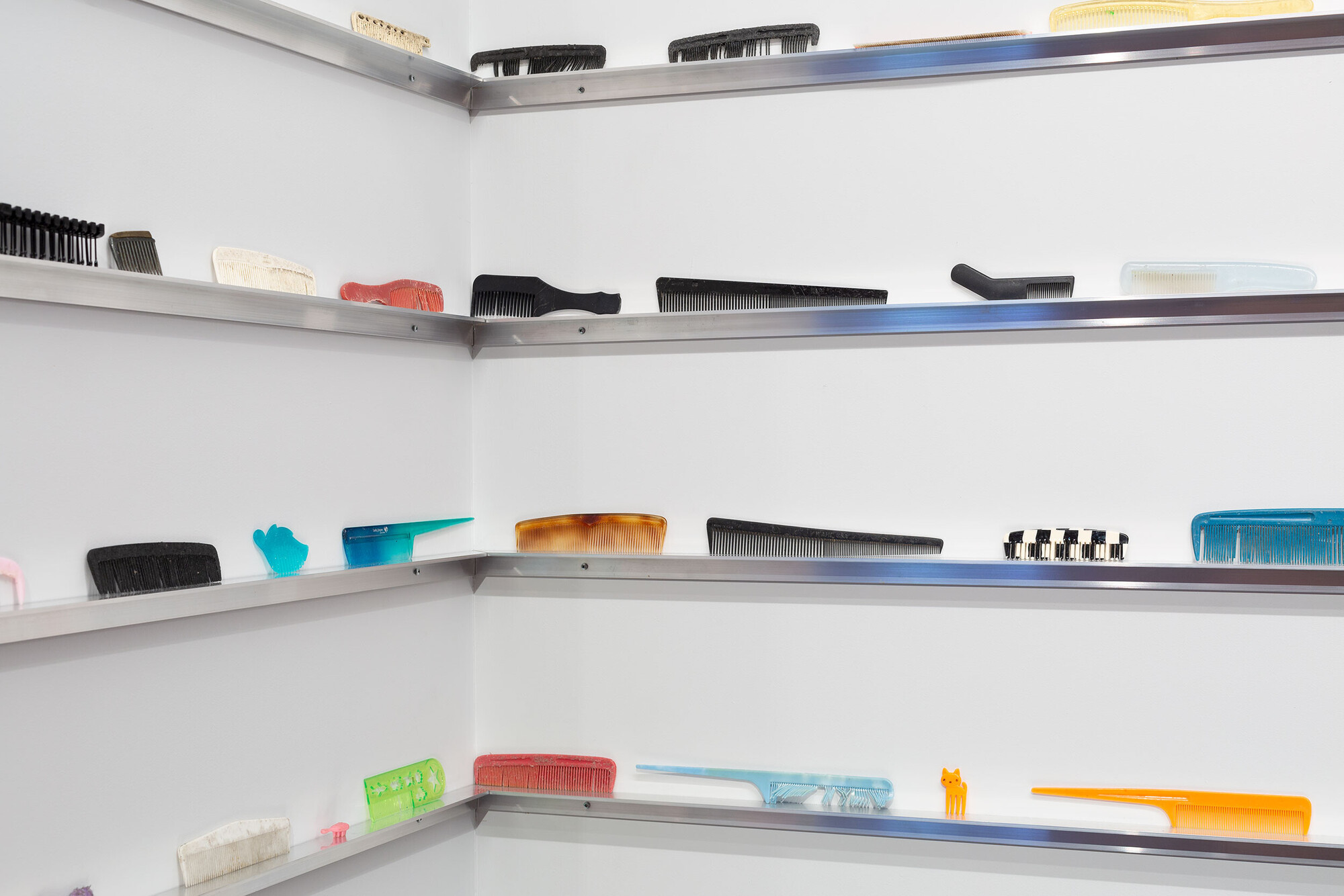
Hair Pieces installation view, Heide Museum of Modern Art, photograph: Christian Capurro.
The exhibition also has a few creature-like sculptures, such as John Meade’s Self Portait as Mary Magdalene (2003–2009). Similar to the Addams Family’s Cousin Itt, it features a resin humanoid covered in a black wig, with only fragments of their hands and feet visible. Positioned above human height on a red wall that also showcases works by Charlie Sofo, Debris Facility, and Ana Mendieta, the extremities are casts of Meade, turning the piece into a homunculus—the figure that might start cute, speaking in falsetto, then start killing mum’s new partner in a comedy horror. Though it predates Mike Kelley’s plush toy Little Friend (2007), a hairy blue toy that humorously screams phrases like “Do you really love me?,” the comparison is inevitable. In fact, there is a Whitney-Biennial-in-1993 atmosphere to the exhibition, for the curatorial interest in abjection and identity politics is also reminiscent of Abject Art: Repulsion and Desire in American Art. Janine Antoni’s Loving Care (1993) where the artist paints the ground with her hair, is an example of a work from that era, as well as Louise Weaver and Peter Ellis’s Leonardo’s Wish (1992) and Fairy Tale (1995) by Helen Wright.
Georgia Banks echoes the icky affect with her nearby work Girl Arranging Her Hair (2012–ongoing), a ball of her hair accumulated over the years to form a substantial mass. I first encountered this work in her studio a few years ago, and even touched it—blarg. Known primarily as a performance artist, this piece captures her physicality, collecting her body’s waste from hours of brushing. The gendered notions of attraction and repulsion it evokes reflect wider themes of Banks’s practice, as she has undergone significant transformations to compete in pageantry competitions. Nearby, Ana Mendieta’s series of seven photographs, Untitled (Facial Hair Transplants) (1972–1997), features her gluing a friend’s bearded hair, strand by strand, to form a moustache above her lips. Dressed in red and gazing at herself in a foggy mirror, Mendieta makes a hilarious parody of the male geniuses often celebrated in art history, highlighting ongoing gendered boundary issues, as measured in the 2022 Countess Report.
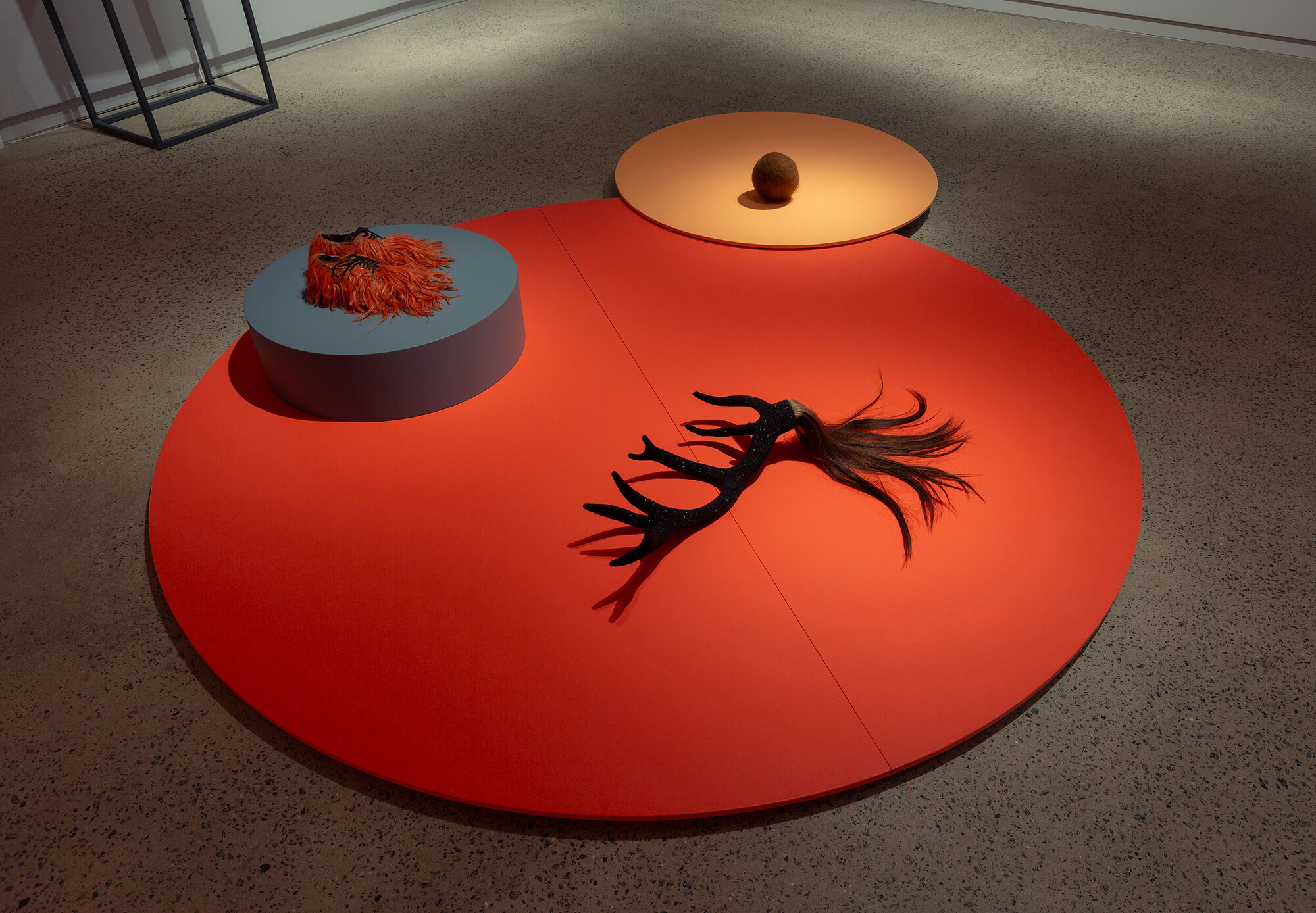
Hair Pieces installation view, Heide Museum of Modern Art, photograph: Christian Capurro.
The exhibition also makes references to the horror genre, best demonstrated in a corner featuring the works of Hayley Millar Baker and Sadie Chandler. These pieces establish a dialogue on the monstrous feminine trope of long hair, creating an uncanny scene. The sequence begins with Baker’s black and white triptych I Will Survive (2020), a set of photographs showing the artist split into doubles and triples by the seaside, reminiscent of Sadako in Ringu (1998), the vengeful spectre with long black hair, worn loose to obscure her face. Baker’s dream-like physicality in the pictures also evokes Maya Deren’s Meshes in the Afternoon (1943), creating a surreal beach atmosphere that inevitably conjures the closing scene of Luis Bunuel’s famous Un Chien Andalou (1929). Curator Melissa Keys has woven a gothic mise-en-scéne invoking the videotape scenes of hair brushing in Ringu by placing Sadie Chandler’s Vanity Set (1993)—two sculptural objects resembling vintage brushes—next to Baker’s work.
Why revisit concerns of abjection and identity politics today, without spinning the framework to generate a critical insight? Why are the walls painted in hues of salmon, grey, and red? In Hair Pieces, these questions remain untouched. One wonders if exhibitions are collectively recycling themselves, as a diversion from the material conditions that helps them manifest a program: the organisational structure, funding infrastructure, and cultural policy. The wide variety of works in this exhibition exemplifies the broad range of practices included, looking at the emotional responses that hair elicits, from joy to fear. I believe I’m meant to sign off with a catchy phrase now, thinking back to the quirky titles espoused by left-leaning newspapers like The Guardian: This show reminds me it’s time to visit the museum—cheaper than a haircut!
Diego Ramírez is an artist with dreams, a writer with hopes and a facilitator with beliefs. He is represented by MARS Gallery.
